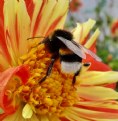The correct answer to this question, as to so many, is "it depends."
I agree with Phillip that you should keep the aperture fixed. But if you allow the camera auto function to take over the shutter speed, you will get very different densities in the sky, which will make stitching more difficult. Or rather it will give you a panorama with strange discontinuities in sky tone.
The above problem grows worse as you use wider-angle lenses, as the camera is pointing in widely different directions. I experience this in an acute form because I shoot some panoramas with an 8mm circular fisheye lens. If you use a lens that is not so wide, you can get away with the differences in sky tone, but of course you have to do a lot more stitching! Some stitching programs are better than others at dealing with this problem. I recommend PTgui for this factor alone.
If you have a digital camera, and try to keep the shutter speed the same to eliminate the above effect, you will run into the problem of limited dynamic range... the shadows will be far too dark and the highlights will be burnt out in different directions. The only solution here is to bracket the exposures and create a high dynamic range image (HDR). By playing around with the settings when you develop each set of RAW images, you can reduce differences in sky tone. But it's not a perfect solution, as the multiple exposures are superimposed in making the HDR, and you can't have moving objects in your picture. OK for scenery or buildings without people.
Another approach is to use film, which has much greater dynamic range, and enables you to skip the HDR step. Hope this helps. I'll answer any other questions you may have, or point you to someone who can.
|
















